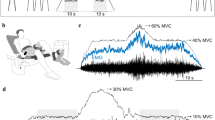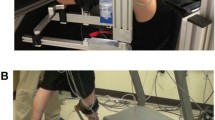Abstract
The effect of long-latency reflex modulation on the performance of a quick adjustment movement following a muscle stretch was studied in 26 healthy male subjects. When the subjects felt a sudden angle displacement in the direction of a wrist extension they were required to make an adjustment movement by moving a handlebar, held in the hand, to align with a target position as quickly and as accurately as possible. The index of performance (adjustment time) was the time taken to move the handle to the target position from stretch onset. A DC torque motor was used to evoke electromyographic (EMG) reflex responses on a wrist flexor. Averaging of the rectified EMG, recorded from surface electrodes placed over the flexor, showed short- and long-latency reflexes (M1 and M2 components). For all subjects, the amplitudes of the reflex components decreased during the adjustment movement because the target position for this study was fixed to the extension side of the wrist joint. The decrease in the M2 component, which is considered to be a transcortical reflex, was significantly larger than the decrease in the M1 component, which is spinal reflex. The main finding was of a positive correlation between the length of adjustment time and the degree of reduction of M1 and M2 with the adjustment movement (r = 0.602 for M1, P < 0.01; r = 0.850 for M2, P < 0.001). Moreover, there were correlations between the consistency of the voluntary response onset and the degree of M2 decrease (r = 0.577, P < 0.01), and between the consistency of the voluntary response onset and the length of the adjustment time (r = 0.603, P < 0.01). Therefore, we have concluded that the subjects who were able to perform adjustment movements within a short time could modulate the long-latency reflex of the muscle involved in such movements in order to make the function of their voluntary muscle activity more effective, and thus were able to respond appropriately.
Similar content being viewed by others
Author information
Authors and Affiliations
Additional information
Accepted: 19 February 1997
Rights and permissions
About this article
Cite this article
Kizuka, T., Asami, T. & Tanii, K. Influence of long-latency reflex modulation on the performance of quick adjustment movements. Eur J Appl Physiol 76, 328–334 (1997). https://doi.org/10.1007/s004210050256
Issue Date:
DOI: https://doi.org/10.1007/s004210050256




